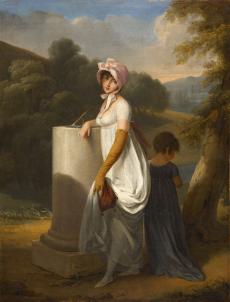


At first sight, one might take this picture for a somewhat informal portrait. The additional presence of a little girl, seen from behind, itself renders that unlikely. Further investigation reveals that it is instead a little group of two figures extracted from one of Louis-Léopold Boilly’s most celebrated paintings, L’Arrivée d’une Diligence dans la Cour des Messageries (Paris, Louvre), painted in 1803, exhibited in the Salon of 1804 and again (exceptionally, because of the change of regime) in that of 1814. Boilly seems to have preferred to keep it, as an illustration of what he could do, rather than to sell it. The Louvre painting is, unusually for him, on panel, which enhances his depiction of exquisite costume, above all. When he was forced to sell at auction part of his collection, including some of his own works, in 1829, he bought this picture back, under an assumed name. At his posthumous sale in 1845 it was bought, for four times its valuation in the inventory, by King Louis-Philippe; and with his deposition in 1848, it passed into the possession of the Louvre.
Such a tour de force required a number of studies, both of the central part of the composition – an exquisitely finished drawing in ink and wash on blue paper, differing from the final painting in a number of respects (also in the Louvre) – and of individual figures. Three of these are listed, and one of them was exhibited, in the catalogue of an exhibition held at the Musée des Beaux-Arts in Lille in 1988-1989. It is a delicious study, in black chalk heightened with white on blue paper that has discoloured to brown, of a young woman in a chapeau cabriolet clutching a handbag and raising the front of her dress – none other than the figure in the present painting.
One might have thought that the drawing was directly made for L’Arrivée d’une Diligence – and indeed, that is what the writers of the entries in both exhibition catalogues (see notes 1 and 3), being unaware of the present painting, have assumed. In the Louvre’s painting, however, the young woman does not hold her dress quite so far out, because of the proximity of the young man she is talking to, and on whom, rather than on us, her gaze is fixed, and because she has a dog at her feet. The little girl is the same as in our picture, but she is differently lit, and she is slightly more occluded by the figure of the young woman. Was this drawing therefore made for our painting? Boilly does not generally seem to have made such studies for paintings of isolated figures. Was it instead made with L’Arrivée d’une Diligence in mind, in order to extend the original composition outwards, but adapted when incorporated into that? The latter seems more probable, particularly when one takes into account the fact that in both the drawing and L’Arrivée d’une Diligence the young woman’s right arm is by her side, whereas in our painting it rests upon the pedestal of the sundial. This seems a somewhat contrived attitude, and it seems improbable that such a young woman would be taking a walk in a garden in a bonnet, in a glove reaching up beyond her elbow, and clutching a handbag. What seems much more likely is that Boilly, having made such a superb study of the young woman in a drawing, was reluctant just to translate it into a merely ancillary figure in a painting, but thought she deserved to be made the subject of a painting in her own right. And who, seeing the present picture, would say otherwise?
He was a prolific, self-taught painter and draughtsman and was widely admired in his own day for his portraits of the middle class, and for his genre scenes detailing everyday life in 19th-century France. With their radiance and fresh colours, these serve as vivid records of contemporary social life, and his work was widely circulated in the form of engravings during his lifetime.